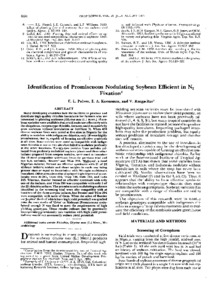| dc.contributor.author | Pulver, E.L. |
| dc.contributor.author | Kueneman, E.A. |
| dc.contributor.author | Ranga-Rao, V. |
| dc.date.accessioned | 2019-12-04T11:24:01Z |
| dc.date.available | 2019-12-04T11:24:01Z |
| dc.date.issued | 1985 |
| dc.identifier.citation | Pulver, E.L., Kueneman, E.A. & Ranga-Rao, V. (1985). Identification of Promiscuous Nodulating Soybean Efficient in N2 Fixation 1. Crop Science, 25(4), 660-663. |
| dc.identifier.issn | 0011-183X |
| dc.identifier.uri | https://hdl.handle.net/20.500.12478/4247 |
| dc.description.abstract | Many developing countries lack the facilities to produce and distribute high quality rhizobia inoculants for farmers who are interested in planting soybeans [Glycine max (L.) Merr.]. If soybean varieties were available that could nodulate effectively with the ubiquitous, cowpea-type rhizobia, farmers could successfully grow soybeans without inoculation or fertilizer N. When 400 diverse soybean lines were tested at five sites in Nigeria for the ability to nodulate with indigenous rhizobia, only 10 were highly promiscuous, that is, capable of forming an effective symbiosis at all sites. Some entries were rated as compatible with indigenous rhizobia at one or two sites but failed to nodulate profusely at the other locations. Twenty-two isolates from nodules collected from profusely nodulated soybean plants and three other isolates prepared from cowpea nodules, were used to inoculate the 10 most compatible selections from the previous trial and two U.S. varieties, ‘Bossier’ and TGm 294. ‘Malayan’, a local Nigerian cultivar, formed an effective symbiosis with 21 of 22 soybean isolates; nodule and shoot weights in each case being greater than or equal to inoculation with Nitragin multistrain inoculant. Other accessions that displayed high degrees of promiscuity were M-381, TGm 120, TGm 119, Indo 180, and Indo 243. Whereas, Bossier formed an effective symbiosis with only one of the isolates, and TGm 294 was compatible with only 2 of the 22 rhizobia isolates. The promiscuously nodulating soybeans identified in the screening trial were also compatible with at least two of the three cowpea isolates, but Bossier and TGm 294 were compatible with none of them. When the scion of Bossier on ‘Jupiter’ (both of which have high yield potential) was grafted onto the root stocks of ‘Orba’ or Malayan (Promiscuous nodulators) enough N was fixed to meet the requirements of high yielding genotypes. These results indicate that by genetically incorporating promiscuity into varieties with high yield potential one would not necessarily reduce yield potential. |
| dc.description.sponsorship | United Nations Development Programme |
| dc.language.iso | en |
| dc.subject | Soybeans |
| dc.subject | Glycine Max |
| dc.subject | Farming Systems |
| dc.subject | Nodulation |
| dc.title | Identification of promiscuous nodulating soybeans efficient in N2 fixation |
| dc.type | Journal Article |
| dc.type | Journal Article |
| dc.description.version | Peer Review |
| cg.contributor.affiliation | International Institute of Tropical Agriculture |
| cg.contributor.affiliation | International Center for Tropical Agriculture |
| cg.contributor.affiliation | Kettering Research Institute, Ohio |
| cg.coverage.region | Africa |
| cg.coverage.region | West Africa |
| cg.coverage.region | East Africa |
| cg.coverage.country | Nigeria |
| cg.coverage.country | Tanzania |
| cg.isijournal | ISI Journal |
| cg.authorship.types | CGIAR and developing country institute |
| cg.iitasubject | Soybean |
| cg.iitasubject | Farmng Systems |
| cg.accessibilitystatus | Limited Access |
| local.dspaceid | 99813 |

